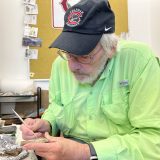
A New App to Help Autism Is On the Horizon
June 12, 2014
This article, written by David Ogul, originally appeared on the Los Angeles Times website.
As researchers at Chapman University break new ground in mining big data, an app developed by a group of its students is poised to take that knowledge to the next level — a practical, Internet-based tool that could help parents and caregivers make the best-possible treatment decisions for children with autism spectrum disorders.
Called the Autism Management Platform, the app evolved from a project of students in a software engineering course who were tasked with developing a tool to aid parents of children with autism. All 25 students in the class were involved, some with coding, some with requirements analysis and some with testing.
The results were eye opening.
“We didn’t realize until the end of the semester that we would have such a platform with so many options,” said their professor, Erik Linstead of Chapman University’s Schmid College of Science and Technology. “The reaction of people I would show it to was, `Wow, this is the beginning of something. You should keep going with this.’”
A handful of the students from the class joined graduate students in working with Linstead to perfect the platform.
“We started reaching out to parents, educators and clinicians to see how we needed to evolve the tool so it could be deployed and start helping people,” Linstead said.
Chapman University describes the Autism Management Platform as an integrated, Internet-based tool for creating, managing and mining big data associated with the treatment of children diagnosed with autism spectrum disorders. Linstead unveiled the app at a Dec. 11 seminar at the Center for Autism and Neurodevelopmental Disorders in Santa Ana.
“We wanted to use our expertise in this area to help folks currently involved in ASD treatment plans who find themselves sidetracked by the huge volumes of data generated by the process,” Linstead said.
The demand for better autism treatment is staggering. One in 88 children are believed to be living with autism spectrum disorder, and that number is expected to grow.
“In talking with parents who have to deal with countless numbers of clinicians, therapists, educators, etc., it became clear this was an area where there would be tangible benefit if we could improve the way data was collected and communicated, and especially the way it was analyzed by medical professionals,” Linstead said. “This is probably true about health care in general, but we thought we would have a better chance of making useful tools if we targeted a more specific area.”
Linstead’s team continues to fine tune the app, and he hopes to launch user testing by the spring, perhaps at an autism center or with a special day class. “The parents and clinicians we’ve talked to are very excited about this. The potential is huge,” he said. “I would like to think that at some point it will be deployed somewhere to make life easier for someone.”

